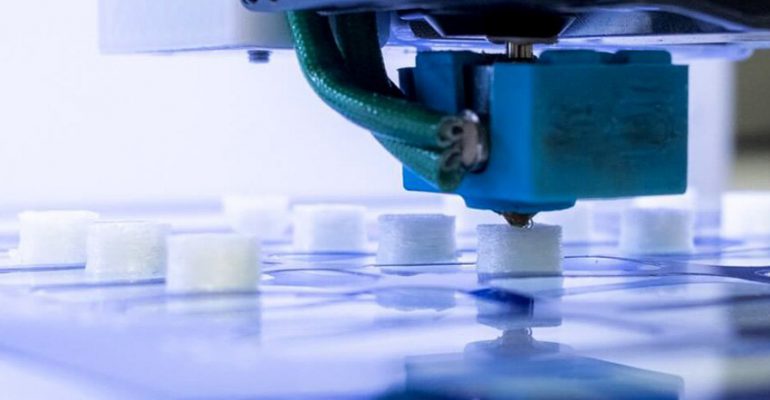3D Printing in the Pharmaceutical Industry
January 28, 2022 2022-02-25 4:453D Printing in the Pharmaceutical Industry
3D Printing is a technology also known as Additive Manufacturing that combines material science and engineering. Material is deposited layer by layer to give rise to a three-dimensional object, following a digital input file containing a model of the object we intend to produce. When it comes to medicine, there are four core uses of 3D Printing – printing tissues and organoids, making precision surgical tools, developing patient-specific surgical models as well as prosthetics. 3D Printing technologies could have a pivotal role in the future of personalized medicine because they have the potential to address the requirements of patient-specific therapies, on-demand production of pharmaceuticals, etc. It is estimated that the worth of 3D bioprinting in the medical field will go up to $3.5 billion by 2025, compared to $713.3 million in 2016. The annual growth rate is estimated to be 17.7 percent, with some reports projecting it to 21%.
In July 2015, the USFDA approved the drug Spritam® – a levetiracetam tablet used for treating epilepsy. It is the first drug to be manufactured using 3D Printing technology, by the company Aprecia Pharmaceuticals. The company used its proprietary “ZipDose Technology” for formulating the drug. By using this 3D printing technology, a large amount of the drug was accommodated along with well-established excipients in a solid dosage form that disintegrates very quickly when taken with a liquid. Quick dispersion was not a new concept, but quick oral dispersion along with high dose delivery was groundbreaking, especially for the end-users in this scenario. Patients with epilepsy often struggle to swallow tablets, so they end up skipping their prescriptions. When they missed a dose, studies showed higher incidences of seizures. Hence, by having such a “fast-melt” dosage form, patients have been saved from the hassle of swallowing tablets because Spritam® dissolves in the mouth! This technology could also benefit children and elders who might struggle to swallow pills.
When the material used for 3D Printing is of biological nature, it is referred to as 3D Bioprinting. This technology is being applied in the field of regenerative medicine to address issues faced with respect to organ transplantation. But when it comes to growing organs in vitro using 3D printing techniques, one of the biggest challenges faced in the field is achieving microvasculature – the small blood vessels that are part of the vascular network to transport blood through the body. To put it simply, they are crucial for survival and their absence could lead to the death of the tissue. The biomaterials that are relevant to producing vascular networks are hydrogels like gelatin, hydroxyapatite, and alginate, composite materials, and decellularized extracellular matrix (dECM), since blood vessels are soft tissue. Biomaterials are used in the form of a ‘bio-ink’ that is ejected out of a nozzle to print the tissue onto a moving bed. All actions are precisely controlled to achieve proper layering of cells. The biomaterials will be used provided they satisfy conditions like biocompatibility, desired shear thinning behavior, shape fidelity, and strength in holding the tissue together once printed.
Prellis Biologics, Inc. at San Francisco uses a laser-based 3D Bioprinting approach to address the problem of the microvasculature. The company developed an Externalized Immune System Platform called EXIS, which is basically human lymph organoids that can be used to produce antibodies in vitro. By injecting antigens, the development of antibodies can be achieved. The company achieved this in 2017 against the Zika virus and also produced around 300 antibodies against SARS-Cov-2 in 2020. Taking this approach significantly lowers the time and resources required to develop antibody therapies because it skips the stages of finding donors or performing animal tests. The company’s accelerator IndieBio, states on their website that Prellis has the world’s fastest high-resolution bioprinter with 100x better printing resolution than any others, using a laser-based printing approach.
3D Printing and Bioprinting hold vast potential for growth in the field of healthcare and pharmaceuticals, as is evident from some of the examples above. But there are still a lot of considerations required in terms of quality testing and regulations. The USFDA discusses a few important questions in this regard as one set of regulations may not fit all the aspects of 3D printing for medicine. 3D Printers involve multiple components within the printing device, the software, and the ink formulation. It gets more complicated when a personalized approach needs to be taken for patients with unique needs. Being able to use an API for 3D printing poses challenges too.
3D Printing technologies are more established in areas like artificial skin transplants, surgical models, and prosthetics, but current research and improvements to the technology are ushering in a new addition to pharmaceutical manufacturing as well.
References:
- Jamróz, W., Szafraniec, J., Kurek, M., & Jachowicz, R. (2018). 3D Printing in Pharmaceutical and Medical Applications – Recent Achievements and Challenges. Pharmaceutical research, 35(9), 176. https://doi.org/10.1007/s11095-018-2454-x
- U.S. Food and Drug Administration. 2021. Promise and Potential of 3D Printed Pharmaceuticals. [online] Available at: https://www.fda.gov/drugs/news-events-human-drugs/cder-researchers-explore-promise-and-potential-3d-printed-pharmaceuticals [Accessed 17 November 2021].
- West, Thomas & Bradbury, Thomas. (2019). 3D Printing: A Case of ZipDose® Technology – World’s First 3D Printing Platform to Obtain FDA Approval for a Pharmaceutical Product: Process Engineering and Additive Manufacturing. 10.1002/9783527813704.ch3.
- IndieBio, https://indiebio.co/company/prellis-biologics/
- Prellis Rapid Human Antibody Discovery, https://www.prellisbio.com/antibodydiscovery
- News article on Prellis, http://outbreaknewstoday.com/san-francisco-company-generates-300-human-antibodies-that-bind-the-sars-cov2-virus-16950/
Authored by Sai Priyanka, Batch 20, Biocon KGI Certificate Program in Biosciences
Image Source - https://www.3dnatives.com/en/3d-printed-drugs-personalized-medicine-140520204/








